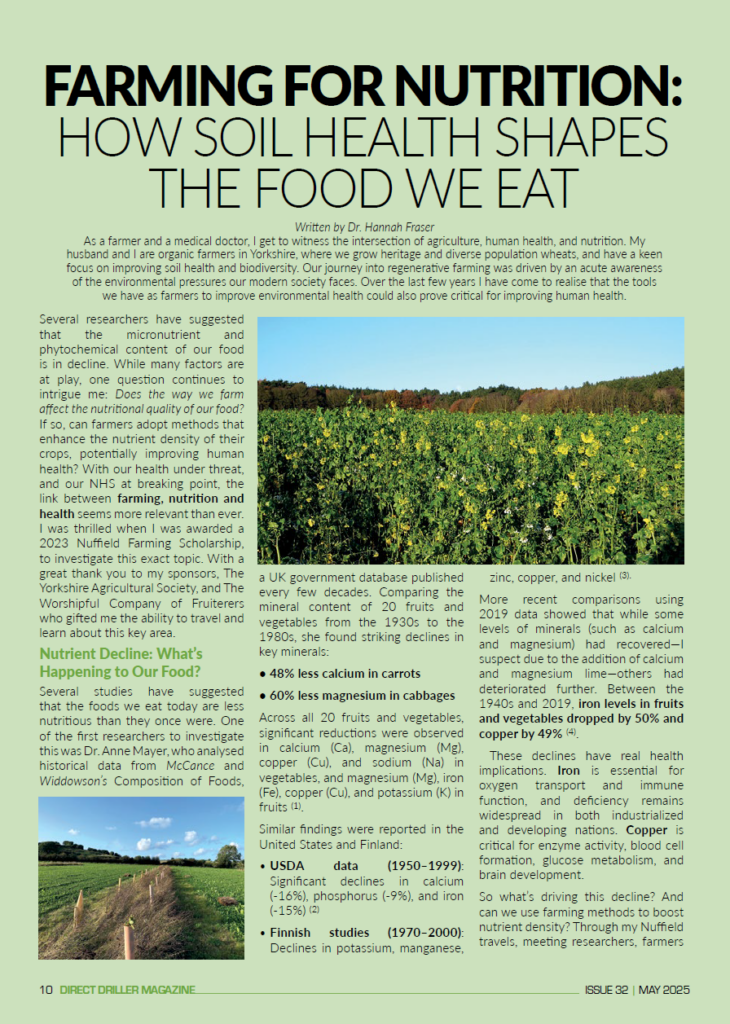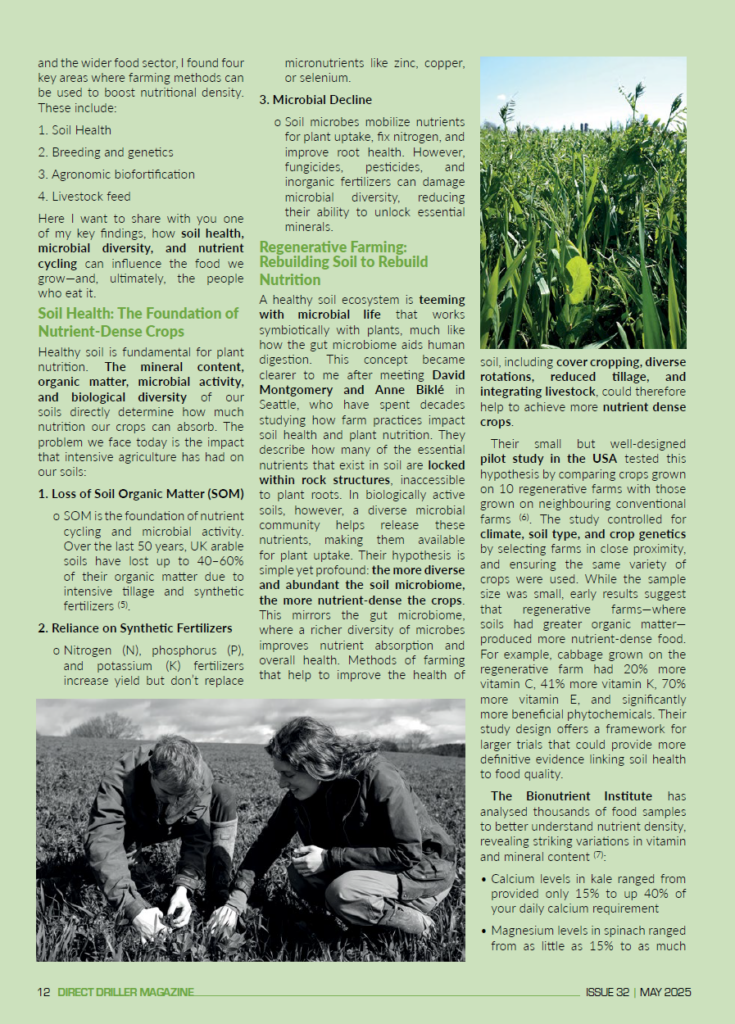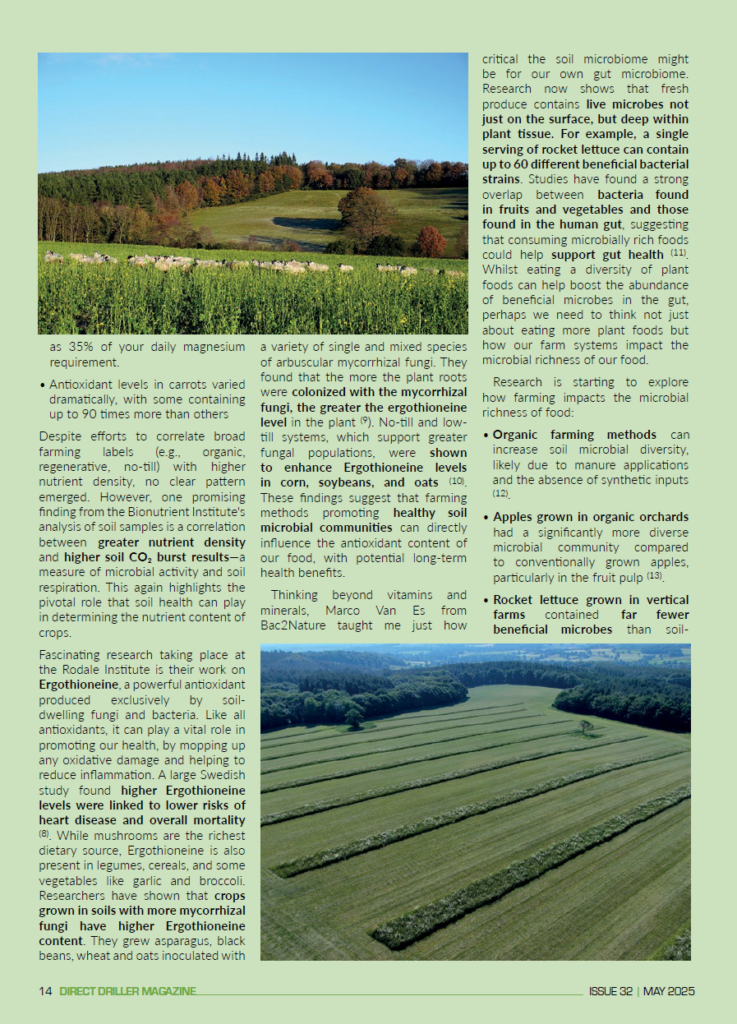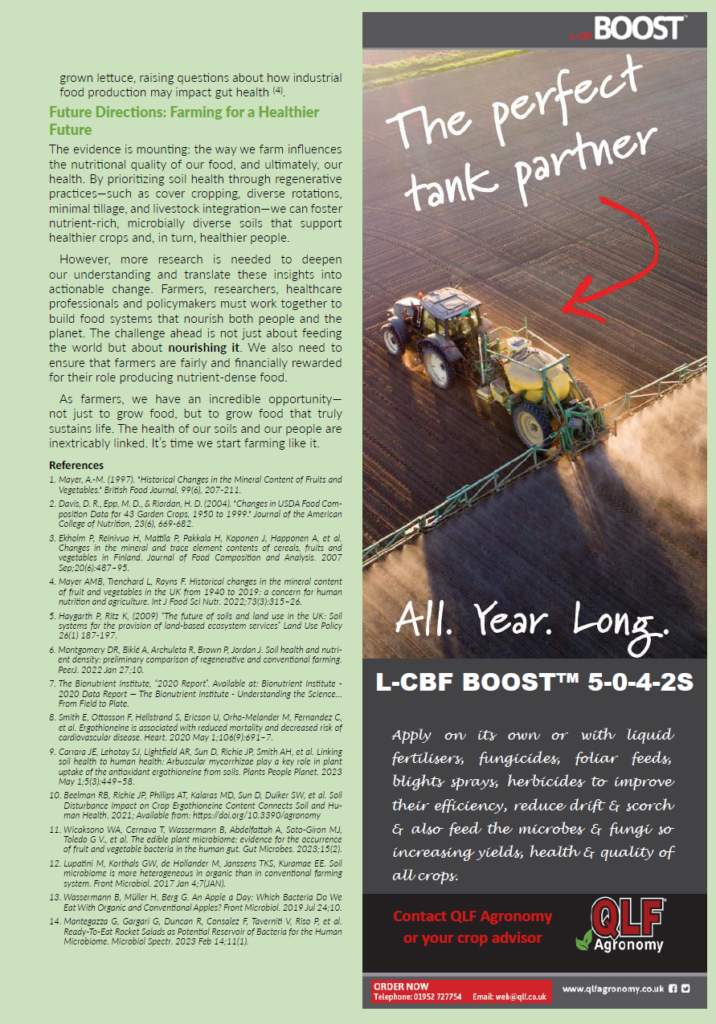Written by Dr. Hannah Fraser
As a farmer and a medical doctor, I get to witness the intersection of agriculture, human health, and nutrition. My husband and I are organic farmers in Yorkshire, where we grow heritage and diverse population wheats, and have a keen focus on improving soil health and biodiversity. Our journey into regenerative farming was driven by an acute awareness of the environmental pressures our modern society faces. Over the last few years I have come to realise that the tools we have as farmers to improve environmental health could also prove critical for improving human health.
Several researchers have suggested that the micronutrient and phytochemical content of our food is in decline. While many factors are at play, one question continues to intrigue me: Does the way we farm affect the nutritional quality of our food? If so, can farmers adopt methods that enhance the nutrient density of their crops, potentially improving human health? With our health under threat, and our NHS at breaking point, the link between farming, nutrition and health seems more relevant than ever. I was thrilled when I was awarded a 2023 Nuffield Farming Scholarship, to investigate this exact topic. With a great thank you to my sponsors, The Yorkshire Agricultural Society, and The Worshipful Company of Fruiterers who gifted me the ability to travel and learn about this key area.
Nutrient Decline: What’s Happening to Our Food?
Several studies have suggested that the foods we eat today are less nutritious than they once were. One of the first researchers to investigate this was Dr. Anne Mayer, who analysed historical data from McCance and Widdowson’s Composition of Foods, a UK government database published every few decades. Comparing the mineral content of 20 fruits and vegetables from the 1930s to the 1980s, she found striking declines in key minerals:
- 48% less calcium in carrots
- 60% less magnesium in cabbages
Across all 20 fruits and vegetables, significant reductions were observed in calcium (Ca), magnesium (Mg), copper (Cu), and sodium (Na) in vegetables, and magnesium (Mg), iron (Fe), copper (Cu), and potassium (K) in fruits (1).
Similar findings were reported in the United States and Finland:
- USDA data (1950–1999): Significant declines in calcium (-16%), phosphorus (-9%), and iron (-15%) (2).
- Finnish studies (1970–2000): Declines in potassium, manganese, zinc, copper, and nickel (3).
More recent comparisons using 2019 data showed that while some levels of minerals (such as calcium and magnesium) had recovered—I suspect due to the addition of calcium and magnesium lime—others had deteriorated further. Between the 1940s and 2019, iron levels in fruits and vegetables dropped by 50% and copper by 49% (4).
These declines have real health implications. Iron is essential for oxygen transport and immune function, and deficiency remains widespread in both industrialized and developing nations. Copper is critical for enzyme activity, blood cell formation, glucose metabolism, and brain development.

So what’s driving this decline? And can we use farming methods to boost nutrient density? Through my Nuffield travels, meeting researchers, farmers and the wider food sector, I found four key areas where farming methods can be used to boost nutritional density. These include:
- Soil Health
- Breeding and genetics
- Agronomic biofortification
- Livestock feed
Here I want to share with you one of my key findings, how soil health, microbial diversity, and nutrient cycling can influence the food we grow—and, ultimately, the people who eat it.
Soil Health: The Foundation of Nutrient-Dense Crops
Healthy soil is fundamentalfor plant nutrition.The mineral content, organic matter, microbial activity, and biological diversity of our soils directly determine how much nutrition our crops can absorb. The problem we face today is the impact that intensive agriculture has had on our soils:
- Loss of Soil Organic Matter (SOM)
- SOM is the foundation of nutrient cycling and microbial activity. Over the last 50 years, UK arable soils have lost up to 40–60% of their organic matter due to intensive tillage and synthetic fertilizers (5).
- Reliance on Synthetic Fertilizers
- Nitrogen (N), phosphorus (P), and potassium (K) fertilizers increase yield but don’t replace micronutrients like zinc, copper, or selenium.
- Microbial Decline
- Soil microbes mobilize nutrients for plant uptake, fix nitrogen, and improve root health. However, fungicides, pesticides, and inorganic fertilizers can damage microbial diversity, reducing their ability to unlock essential minerals.
Regenerative Farming: Rebuilding Soil to Rebuild Nutrition
A healthy soil ecosystem is teeming with microbial life that works symbiotically with plants, much like how the gut microbiome aids human digestion. This concept became clearer to me after meeting David Montgomery and Anne Biklé in Seattle, who have spent decades studying how farm practices impact soil health and plant nutrition. They describe how many of the essential nutrients that exist in soil are locked within rock structures, inaccessible to plant roots. In biologically active soils, however, a diverse microbial community helps release these nutrients, making them available for plant uptake. Their hypothesis is simple yet profound: the more diverse and abundant the soil microbiome, the more nutrient-dense the crops. This mirrors the gut microbiome, where a richer diversity of microbes improves nutrient absorption and overall health. Methods of farming that help to improve the health of soil, including cover cropping, diverse rotations, reduced tillage, and integrating livestock, could therefore help to achieve more nutrient dense crops.
Their small but well-designed pilot study in the USA tested this hypothesis by comparing crops grown on 10 regenerative farms with those grown on neighbouring conventional farms (6). The study controlled for climate, soil type, and crop genetics by selecting farms in close proximity, and ensuring the same variety of crops were used. While the sample size was small, early results suggest that regenerative farms—where soils had greater organic matter—produced more nutrient-dense food. For example, cabbage grown on the regenerative farm had 20% more vitamin C, 41% more vitamin K, 70% more vitamin E, and significantly more beneficial phytochemicals. Their study design offers a framework for larger trials that could provide more definitive evidence linking soil health to food quality.

The Bionutrient Institute has analysed thousands of food samples to better understand nutrient density, revealing striking variations in vitamin and mineral content (7):
- Calcium levels in kale ranged from provided only 15% to up 40% of your daily calcium requirement
- Magnesium levels in spinach ranged from as little as 15% to as much as 35% of your daily magnesium requirement.
- Antioxidant levels in carrots varied dramatically, with some containing up to 90 times more than others
Despite efforts to correlate broad farming labels (e.g., organic, regenerative, no-till) with higher nutrient density, no clear pattern emerged. However, one promising finding from the Bionutrient Institute’s analysis of soil samples is a correlation between greater nutrient density and higher soil CO₂ burst results—a measure of microbial activity and soil respiration. This again highlights the pivotal role that soil health can play in determining the nutrient content of crops.
Fascinating research taking place at the Rodale Institute is their work on Ergothioneine, a powerful antioxidant produced exclusively by soil-dwelling fungi and bacteria. Like all antioxidants, it can play a vital role in promoting our health, by mopping up any oxidative damage and helping to reduce inflammation. A large Swedish study found higher Ergothioneine levels were linked to lower risks of heart disease and overall mortality (8). While mushrooms are the richest dietary source, Ergothioneine is also present in legumes, cereals, and some vegetables like garlic and broccoli. Researchers have shown that crops grown in soils with more mycorrhizal fungi have higher Ergothioneine content. They grew asparagus, black beans, wheat and oats inoculated with a variety of single and mixed species of arbuscular mycorrhizal fungi. They found that the more the plant roots were colonized with the mycorrhizal fungi, the greater the ergothioneine level in the plant (9). No-till and low-till systems, which support greater fungal populations, were shown to enhance Ergothioneine levels in corn, soybeans, and oats (10). These findings suggest that farming methods promoting healthy soil microbial communities can directly influence the antioxidant content of our food, with potential long-term health benefits.

Thinking beyond vitamins and minerals, Marco Van Es from Bac2Nature taught me just how critical the soil microbiome might be for our own gut microbiome. Research now shows that fresh produce contains live microbes not just on the surface, but deep within plant tissue. For example, a single serving of rocket lettuce can contain up to 60 different beneficial bacterial strains. Studies have found a strong overlap between bacteria found in fruits and vegetables and those found in the human gut, suggesting that consuming microbially rich foods could help support gut health (11). Whilst eating a diversity of plant foods can help boost the abundance of beneficial microbes in the gut, perhaps we need to think not just about eating more plant foods but how our farm systems impact the microbial richness of our food.
Research is starting to explore how farming impacts the microbial richness of food:
- Organic farming methods can increase soil microbial diversity, likely due to manure applications and the absence of synthetic inputs (12).
- Apples grown in organic orchards had a significantly more diverse microbial community compared to conventionally grown apples, particularly in the fruit pulp (13).
- Rocket lettuce grown in vertical farms contained far fewer beneficial microbes than soil-grown lettuce, raising questions about how industrial food production may impact gut health (14).
Future Directions: Farming for a Healthier Future
The evidence is mounting: the way we farm influences the nutritional quality of our food, and ultimately, our health. By prioritizing soil health through regenerative practices—such as cover cropping, diverse rotations, minimal tillage, and livestock integration—we can foster nutrient-rich, microbially diverse soils that support healthier crops and, in turn, healthier people.
However, more research is needed to deepen our understanding and translate these insights into actionable change. Farmers, researchers, healthcare professionals and policymakers must work together to build food systems that nourish both people and the planet. The challenge ahead is not just about feeding the world but about nourishing it. We also need to ensure that farmers are fairly and financially rewarded for their role producing nutrient-dense food.
As farmers, we have an incredible opportunity—not just to grow food, but to grow food that truly sustains life. The health of our soils and our people are inextricably linked. It’s time we start farming like it.
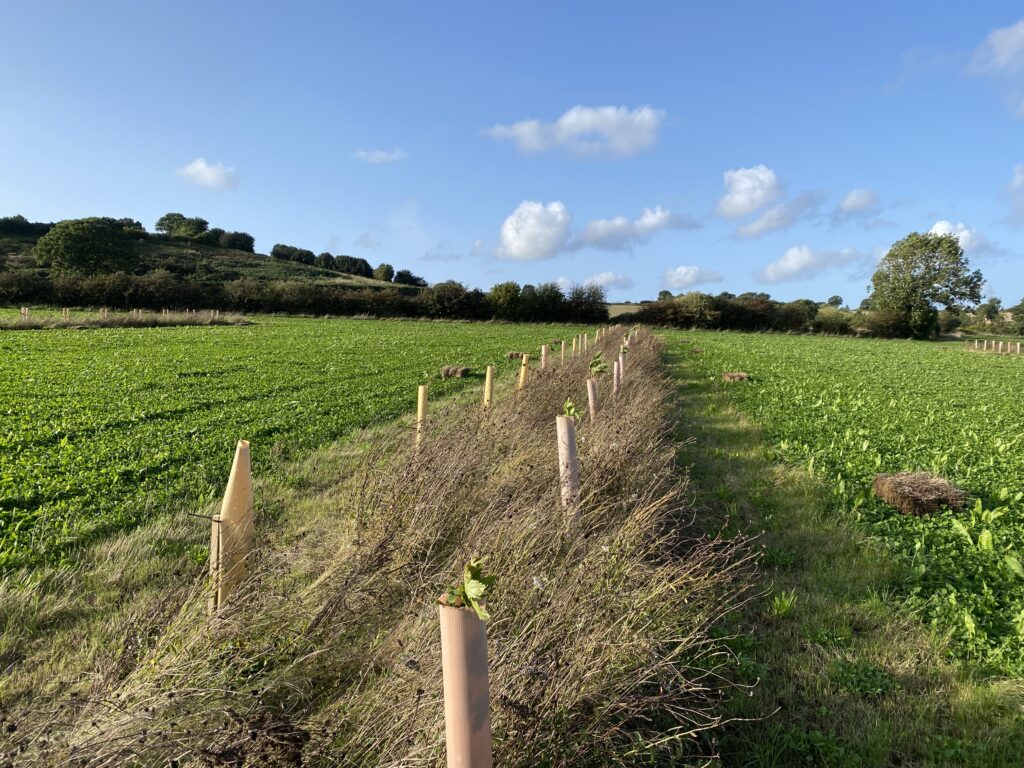
References
- Mayer, A.-M. (1997). “Historical Changes in the Mineral Content of Fruits and Vegetables.” British Food Journal, 99(6), 207-211.
- Davis, D. R., Epp, M. D., & Riordan, H. D. (2004). “Changes in USDA Food Composition Data for 43 Garden Crops, 1950 to 1999.” Journal of the American College of Nutrition, 23(6), 669-682.
- Ekholm P, Reinivuo H, Mattila P, Pakkala H, Koponen J, Happonen A, et al. Changes in the mineral and trace element contents of cereals, fruits and vegetables in Finland. Journal of Food Composition and Analysis. 2007 Sep;20(6):487–95.
- Mayer AMB, Trenchard L, Rayns F. Historical changes in the mineral content of fruit and vegetables in the UK from 1940 to 2019: a concern for human nutrition and agriculture. Int J Food Sci Nutr. 2022;73(3):315–26.
- Haygarth P, Ritz K, (2009) “The future of soils and land use in the UK: Soil systems for the provision of land-based ecosystem services” Land Use Policy 26(1) 187-197.
- Montgomery DR, Biklé A, Archuleta R, Brown P, Jordan J. Soil health and nutrient density: preliminary comparison of regenerative and conventional farming. PeerJ. 2022 Jan 27;10.
- The Bionutrient Institute, “2020 Report”. Available at: Bionutrient Institute – 2020 Data Report — The Bionutrient Institute – Understanding the Science… From Field to Plate.
- Smith E, Ottosson F, Hellstrand S, Ericson U, Orho-Melander M, Fernandez C, et al. Ergothioneine is associated with reduced mortality and decreased risk of cardiovascular disease. Heart. 2020 May 1;106(9):691–7.
- Carrara JE, Lehotay SJ, Lightfield AR, Sun D, Richie JP, Smith AH, et al. Linking soil health to human health: Arbuscular mycorrhizae play a key role in plant uptake of the antioxidant ergothioneine from soils. Plants People Planet. 2023 May 1;5(3):449–58.
- Beelman RB, Richie JP, Phillips AT, Kalaras MD, Sun D, Duiker SW, et al. Soil Disturbance Impact on Crop Ergothioneine Content Connects Soil and Human Health. 2021; Available from: https://doi.org/10.3390/agronomy
- Wicaksono WA, Cernava T, Wassermann B, Abdelfattah A, Soto-Giron MJ, Toledo G V., et al. The edible plant microbiome: evidence for the occurrence of fruit and vegetable bacteria in the human gut. Gut Microbes. 2023;15(2).
- Lupatini M, Korthals GW, de Hollander M, Janssens TKS, Kuramae EE. Soil microbiome is more heterogeneous in organic than in conventional farming system. Front Microbiol. 2017 Jan 4;7(JAN).
- Wassermann B, Müller H, Berg G. An Apple a Day: Which Bacteria Do We Eat With Organic and Conventional Apples? Front Microbiol. 2019 Jul 24;10.
- Mantegazza G, Gargari G, Duncan R, Consalez F, Taverniti V, Riso P, et al. Ready-To-Eat Rocket Salads as Potential Reservoir of Bacteria for the Human Microbiome. Microbiol Spectr. 2023 Feb 14;11(1).
